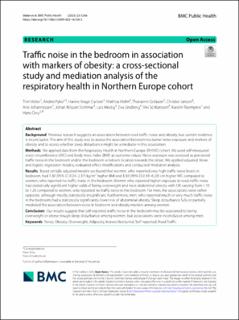| dc.contributor.author | Veber, Triin | |
| dc.contributor.author | Pyko, Andrei | |
| dc.contributor.author | Carlsen, Hanne Krage | |
| dc.contributor.author | Holm, Mathias | |
| dc.contributor.author | Gislason, Thorarinn | |
| dc.contributor.author | Janson, Christer | |
| dc.contributor.author | Johannessen, Ane | |
| dc.contributor.author | Sommar, Johan Nilsson | |
| dc.contributor.author | Modig, Lars | |
| dc.contributor.author | Lindberg, Eva | |
| dc.contributor.author | Schlünssen, Vivi | |
| dc.contributor.author | Toompere, Karolin | |
| dc.contributor.author | Orru, Hans | |
| dc.date.accessioned | 2024-02-01T14:04:56Z | |
| dc.date.available | 2024-02-01T14:04:56Z | |
| dc.date.created | 2023-08-28T13:50:13Z | |
| dc.date.issued | 2023 | |
| dc.identifier.issn | 1471-2458 | |
| dc.identifier.uri | https://hdl.handle.net/11250/3115102 | |
| dc.description.abstract | Background
Previous research suggests an association between road traffic noise and obesity, but current evidence is inconclusive. The aim of this study was to assess the association between nocturnal noise exposure and markers of obesity and to assess whether sleep disturbance might be a mediator in this association.
Methods
We applied data from the Respiratory Health in Northern Europe (RHINE) cohort. We used self-measured waist circumference (WC) and body mass index (BMI) as outcome values. Noise exposure was assessed as perceived traffic noise in the bedroom and/or the bedroom window’s location towards the street. We applied adjusted linear, and logistic regression models, evaluated effect modifications and conducted mediation analysis.
Results
Based on fully adjusted models we found that women, who reported very high traffic noise levels in bedroom, had 1.30 (95% CI 0.24–2.37) kg/m2 higher BMI and 3.30 (95% CI 0.39–6.20) cm higher WC compared to women, who reported no traffic noise in the bedroom. Women who reported higher exposure to road traffic noise had statistically significant higher odds of being overweight and have abdominal obesity with OR varying from 1.15 to 1.26 compared to women, who reported no traffic noise in the bedroom. For men, the associations were rather opposite, although mostly statistically insignificant. Furthermore, men, who reported much or very much traffic noise in the bedroom, had a statistically significantly lower risk of abdominal obesity. Sleep disturbance fully or partially mediated the association between noise in bedroom and obesity markers among women.
Conclusion
Our results suggest that self-reported traffic noise in the bedroom may be associated to being overweight or obese trough sleep disturbance among women, but associations were inconclusive among men. | en_US |
| dc.language.iso | eng | en_US |
| dc.publisher | BMC | en_US |
| dc.rights | Navngivelse 4.0 Internasjonal | * |
| dc.rights.uri | http://creativecommons.org/licenses/by/4.0/deed.no | * |
| dc.title | Traffic noise in the bedroom in association with markers of obesity: a cross-sectional study and mediation analysis of the respiratory health in Northern Europe cohort | en_US |
| dc.type | Journal article | en_US |
| dc.type | Peer reviewed | en_US |
| dc.description.version | publishedVersion | en_US |
| dc.rights.holder | Copyright 2023 The Author(s) | en_US |
| dc.source.articlenumber | 1246 | en_US |
| cristin.ispublished | true | |
| cristin.fulltext | original | |
| cristin.qualitycode | 1 | |
| dc.identifier.doi | 10.1186/s12889-023-16128-2 | |
| dc.identifier.cristin | 2170246 | |
| dc.source.journal | BMC Public Health | en_US |
| dc.identifier.citation | BMC Public Health. 2023, 23 (1), 1246. | en_US |
| dc.source.volume | 23 | en_US |
| dc.source.issue | 1 | en_US |

